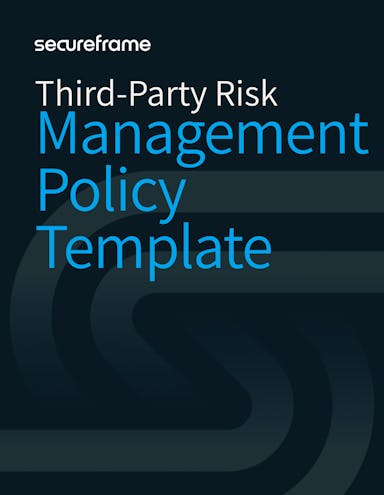Effective third-party risk management is crucial in today's interconnected business landscape. Most organizations rely on a network of external partners for products and services, creating dependencies that introduce security, operational, and reputational risks.
In an analysis by Cyentia Institute, the average organization had around 10 third-party relationships and nearly all (98%) had at least one third-party partner who had suffered a data breach. It’s a stark reminder of why managing vendor relationships effectively is vital to protecting your business.
This guide explains how you can safeguard your organization with an effective third-party risk management program and provides a policy template to get you started.
What is third-party risk management?
Third-party risk management (TPRM) is a process organizations use to identify, assess, mitigate, monitor, and resolve the risks associated with their relationships with third parties. Third parties include vendors, suppliers, contractors, partners, software providers, open source projects, and other outsourcing.
Why does this matter? Many of these partners access your data, systems, or facilities, making their vulnerabilities your vulnerabilities. Without robust TPRM, you risk data breaches, compliance violations, financial losses, reputational damage, and even legal liabilities.
Third-party risk management is essential for ensuring your organization’s security, compliance, and resilience. Let’s explore some key areas a TPRM program protects:
1. Data security and privacy
Third parties may have access to your organization's sensitive data and systems. If they have inadequate security measures, then you’re vulnerable to data breaches that may expose valuable information about your organization, employees, customers, or partners.
Data breaches caused by third parties are also more expensive, according to IBM research. In 2022, data breaches cost organizations an average of $4.35 million but data breaches caused by third parties cost $4.37 million on average — or an additional $247,624 to be exact.
Third-party risk management can therefore reduce the probability and costs of third-party data breaches.
2. Reputation management
Data breaches, compliance violations, unethical practices, and other issues caused by third parties can damage your organization's reputation and erode customer trust and confidence in your brand. Third-party risk management can help prevent or mitigate these negative consequences.
3. Legal and regulatory compliance
If your organization is subject to regulatory requirements regarding data privacy and security, then you may also be responsible for ensuring your third-party partners meet these requirements as well. For example, PCI DSS requires that all third-party service providers demonstrate PCI DSS compliance through regular risk assessments.
Third-party risk management can help you identify and manage compliance risks inherent to third-party relationships.
4. Business continuity
Relying on third parties for critical services or supplies means that any disruptions to their operations could impact your organization's ability to operate. Effective risk management, business continuity planning, and ensuring notifications of appropriate personnel can help prevent these disruptions or ensure your organization is able to resume operations during and after disruptions if they occur.
5. Supply chain resilience
Similarly, third-party risk management can help you identify and manage risks and vulnerabilities throughout your supply chain to improve its resilience. This is particularly important as supply chains become more complex and global, introducing new environmental, strategic, and operational risks, among others.
Recommended reading

Supply Chain Risk Management: A Breakdown of the Process + Policy Template
Read MoreBuilding a third-party risk management framework
Having a comprehensive third-party risk management framework can help you capture the full lifecycle and secure your entire third-party ecosystem.
Here’s how to build a vendor risk management framework for your organization:
- Inventory your vendors: Create a list of all third-party vendors, including suppliers, contractors, and service providers.
- Segment by risk: Classify third parties based on the level of risk they pose. High-risk vendors may handle sensitive data, while low-risk ones provide routine services.
- Conduct due diligence: Before partnering with a third party, evaluate their security controls, compliance history, and financial stability.
- Complete onboarding: A secure vendor onboarding process ensures vendors adhere to specific access controls, implement robust data security measures, undergo security training, and formally accept relevant policies. To help ensure all these steps are covered, we created a vendor onboarding checklist that covers key tasks.
- Establish monitoring processes: Use tools like scorecards and regular vendor risk assessments to track third-party performance and compliance status over time.
- Assign ownership: Designate a team or individual to oversee TPRM activities and ensure accountability.
- Leverage automation: Invest in tools that automate workflows, track data, and provide real-time risk insights.
Recommended reading

The Ultimate Guide To Effective Vendor Risk Assessments: 47 Questions to Ask to Protect Your Business
Read MoreThird-party risk management best practices for stronger cybersecurity
Implementing effective third-party risk management involves following a set of best practices to identify, assess, mitigate, and monitor risks associated with third parties. To strengthen your TPRM program, consider these best practices:
Identify and categorize third-party risks
Maintain a comprehensive inventory of all third-party relationships and categorize them based on the criticality of their services and the sensitivity of data they access. They should be separated into three risk exposure tiers: High, Medium, and Low. Focus resources on high-risk vendors to maximize impact.
Establish criteria for vendor selection and conduct due diligence
Establish clear criteria for vendor selection and conduct thorough due diligence before entering into contracts with third parties. Due diligence might involve evaluating their financial stability, security controls, compliance history, and reputation.
Specify requirements in contract
Contracts should outline minimum information security standards and controls and any compliance requirements that third parties must adhere to. These should be based on your organization’s risk tolerance and data security and privacy policies, and include service level agreements for data protection and incident response.
Perform periodic risk assessments
Assess vendors annually or more frequently for high-risk partners. These risk assessments should consider whether the vendor is customer-facing, receives or stores confidential data, presents a supply chain risk, has strong security measures in place, and has undergone third-party audits. A comprehensive third-party risk assessment factors in cybersecurity risk, financial risk, reputational risk, strategic risk, and compliance risk.
Monitor performance metrics
Establish key performance indicators (KPIs) for third parties and regularly review and assess their performance against these metrics. They can relate to service delivery, inherent risk, security, compliance, and more.
Develop an exit strategy
Develop procedures for terminating a relationship with a third party. These procedures should ensure proper data transfer or deletion and be documented in contracts with third parties.
Involve key stakeholders
Effective third-party risk management processes involve internal stakeholders across the organization. For example, stakeholders from legal, compliance, and IT departments should be aligned and coordinate on risk management activities.
Document everything
Document all risk assessments, due diligence, contracts, communication, and risk mitigation activities related to third parties as evidence of your compliance efforts.
Set up a process for continuous monitoring
Implement a process for ongoing monitoring of third parties to detect any changes in risk factors or performance. This will enable you to reassess based on your risk profile, change mitigation strategies, and terminate relationships if needed.
Leverage automation
Managing third-party risk management with outdated tools like spreadsheets can be manually intensive — but it doesn’t have to be. Automation can help reduce the time and resources needed for collecting vendor information, supplier risk assessments, personnel management, continuous monitoring, and other activities essential for third-party risk management.
By implementing these best practices as part of your third-party risk management program, you can help safeguard your organization's data, operations, reputation, and security and compliance posture while maintaining productive vendor relationships.
Understanding the third-party risk management lifecycle
Managing third-party risks isn’t a one-time task — it’s an ongoing process. A strategic approach to this process not only protects your organization, but also helps you collaborate with vendors to effectively manage complexities like fourth-parties (your vendors’ vendors) that can amplify vulnerabilities. Let’s explore how each phase contributes to a comprehensive TPRM strategy.
1. Identification of existing and new third parties
Identify all existing third parties with whom the organization has a business relationship. This includes vendors, suppliers, service providers, contractors, consultants, and other external entities.
2. Evaluation and selection of new third parties
Any new parties should be evaluated before moving forward to the next step. Your organization may use requests for proposals or security questionnaires if evaluating multiple parties for the same service. The decision to move forward with a third party may be based on a range of factors that align with the organization’s needs, such as cost.
3. Risk assessment and due diligence
Next, conduct a risk assessment and appropriate due diligence before entering or extending a contract with third parties and granting access to your systems. These should be performed to determine the possible risk and impact each third-party relationship poses to your organization.
This assessment and due diligence should answer the following questions:
- Is the third party of a customer-facing nature?
- Would the third party be involved in receiving and storing confidential data (eg. customer data, employee data, regulatory data, or financial data)? If so, where does the third party use, access, and store such data?
- What security controls and measures does the third party have in place?
- What security policies does the third party have in place? Request to review them.
- Has the third party undergone third-party audits (such as SOC 2®, HITRUST, ISO 27001)? Request to review the reports.
- Is there a risk of regulatory scrutiny and customer harm associated with the third party?
- What is the operational reliance of the third party?
- Does the third party present supply chain risk?
4. Contract review and procurement
Next, establish contractual agreements that outline responsibilities and expectations regarding security controls, data protection, compliance, and incident response. These responsibilities and expectations should apply to your organization as well as the third party. Submit to the third party for review and signature.
5. Risk mitigation
Risk mitigation can occur in tandem with contract review and procurement. After conducting risk assessments, you can begin mitigating the risks you identified and are taking on by entering into third-party relationships. This stage might involve risk quantification or scoring, risk treatment, and risk monitoring.
6. Ongoing monitoring
Third-party relationships must be continuously monitored to reasonably ensure third parties remain in compliance with state and federal law and that services are being provided as intended. This means conducting vendor reviews at least annually, which must be documented and retained for audit purposes.
Annual reviews may include the gathering of applicable compliance reports, like SOC 2, PCI DSS, HITRUST, and ISO 27001, or other evidence of security compliance.
Results of these reviews must be compared to in-place agreements and/or SLAs. If third parties are found to be in violation of any executed agreement(s), action plans and processes may be initiated to remedy the issue(s) or access to your company’s systems may be removed immediately.
7. Third-party offboarding
The final stage of the third-party risk management lifecycle is offboarding, or termination. If you end a business relationship with a third party, you should have procedures in place to ensure that data is securely transferred or deleted and that potential risks are minimized during the transition.

Third-party risk management policy template
Whether you’re creating a third-party risk management policy for the first time or looking to strengthen your current policy, use this template to help build a solid foundation for managing your third-party relationships.
How Secureframe can help you build a robust TPRM program
Managing third-party risks can be overwhelming, but Secureframe makes it easier. Our platform automates security questionnaires, monitors third-party compliance in real time, and provides detailed risk reports. Whether you’re looking to streamline processes or gain deeper insights, we’re here to help.
- Third-party reviews: Secureframe allows you to easily store and review vendor documentation and security ratings to ensure your third parties are compliant.
- Vendor risk assessments: Our platform is enhanced with AI that can automate due diligence questionnaires and risk assessment workflows and provide risk recommendations to simplify the risk assessment process.
- Third-party personnel access tracking: Easily monitor and track third-party personnel system access from a single tool.
- Continuous monitoring: Our automation platform continuously monitors your vendor’s security posture and compliance with regulatory and industry frameworks. When evaluating third-party risk management software, look for one that offers an easy-to-use platform in addition to a team of security and compliance experts to guide your organization through every step of the third-party risk management process.
Looking to safeguard your third-party relationships and better manage your security posture? Schedule a demo with our team today to see how we can fit your needs.